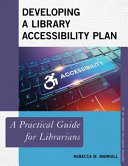2018 School Spending Survey Report
Developing a Library Accessibility Plan: A Practical Guide for Librarians
Rowman & Littlefield.
(Practical Guides for Librarians, Bk. 66).
Aug. 2020.
160p.
ISBN 9781538131138. pap. $65.
PRO MEDIA
COPY ISBN
VERDICT Libraries with limited staff and funds may have difficulty incorporating many of the suggestions without considerable assistance from community partners, but larger libraries will find a practical map for improving accessibility.
ALREADY A SUBSCRIBER? LOG IN
We are currently offering this content for free. Sign up now to activate your personal profile, where you can save articles for future viewing




Comment Policy:
Comment should not be empty !!!